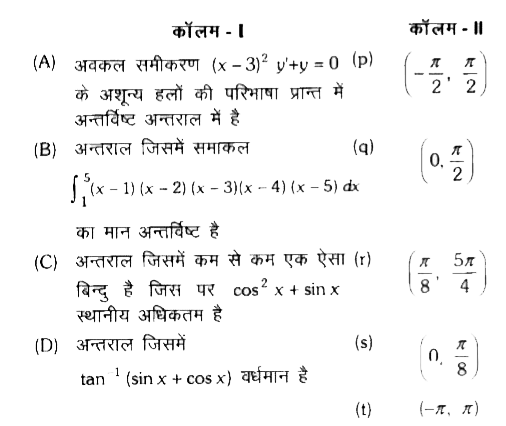यदि y=e−xcosx तथा yn+kny=0 , जहाँ yn=dnydxn तथा kn,n∈N अचर है।
k4=4
k8=−16
k12=20
k16=−24
The correct Answer is:A, B, D
Step by step video, text & image solution for यदि y = e^(-x) cos x तथा y_n + k _n y =0 , जहाँ y_n = ( d^(n)y)/( dx^(n)) तथा k_n , n in N अचर है। by Maths experts to help you in doubts & scoring excellent marks in Class 12 exams.
Updated on:21/07/2023Topper's Solved these Questions
- अवकल समीकरण BOOK - ERRORLESS HINDICHAPTER - अवकल समीकरण EXERCISE - JEE Advanced ( Matrix Match type questions )
3 Videos
- अवकल समीकरण BOOK - ERRORLESS HINDICHAPTER - अवकल समीकरण EXERCISE - EXERCISE
109 Videos
- अनिश्चित समाकलन BOOK - ERRORLESS HINDICHAPTER - अनिश्चित समाकलन EXERCISE - JEE ADVVANCED (MATRIX MATCH TYPE QUESTIONS )
2 Videos
- अवकलन तथा अवकलज के अनुप्रयोगBOOK - ERRORLESS HINDICHAPTER - अवकलन तथा अवकलज के अनुप्रयोगEXERCISE - JEE Advanced (Matrix Match type questions)
22 Videos
Similar Questions

View Solutionसभी केंद्रीय वृतों जिनका केंद्र (h,k) है , के लिए अवकल समीकरण की कोटि है।
View Solutionकॉलम Iकॉलम II(A)यदि∫2x√1−4xdx=ksin−1(f(x))+C,(p)0तो k किससे महत्तम है(B)यदि∫(√x)5(√x)7+x6dx=a lnxkxk+1+c,(q)1हो, तो ak किससे न्यूनतम है(C)∫x4+1x(x2+1)2dx=k ln|x|+m1+x2+n,(r)3जहाँ n समाकलन का अचर है, तो mk किससे महत्तम है(D)∫dx5+4cosx=ktan−1(m tanx2)+C,(s)4 हो k/m किससे महत्तम है
View Solutionकॉलम I में दिये गये वक्तव्यों का कॉलम II में दिये अंतरालों अथवा अंतरालों के सम्मिलन से सुमेल करें
कॉलम -Iकॉलम - II(A)समुच्चय{Re(2iz1−z2):zएकसम्मिश्र संख्या है|z|=1,z≠±1}है(p)(−∞,−1)∪(1,∞)(B)फलनf(x)=sin−1(8(3)x−21−32(x−1))का प्रान्त है(q)(−∞,0)∪(0,∞)(C)यदिf(θ)=∣∣ ∣∣1tanθ1−tanθ1tanθ−1−tanθ1∣∣ ∣∣,तब समुच्चय{f(θ):0≤θ<π2}है(r)[2,∞)(D)यदिf(x)=x3/2(3x−10),x≥0,तबf(x)किसमे वर्धमान है(s)(−∞,−1]∪[1,∞)(t)(−∞,0]∪[2,∞)
View SolutionIf y=e^(-x)cos x and y_(n)+k_(n)y=0 where yn=(d^(n)y)/(dx^(n)) and k_(n) are constant n in N then
View Solutionयदि y=enx, तब सिद्ध कीजिये की yn=nnenx
View Solutiony=eax then dnydxn=yn is:
View Solutionयदि m,n∈R तथा f:R→R एक सतत फलन है जो
f(x)={m2cos2x+n2sin2x, यदि x≤0 emx+n, यदि x>0
द्वारा दिया जाता है, जब
View SolutionIf y=loge x and n is a positive integer, then dnydxn is equal to :
View SolutionIf y=e−xcosxandyn+kny=0,whereyn=dnydxnandkn are constants ∀n∈N, then k4=4 (b) k8=−16 k12=20 (d) k16=−24
View SolutionIf y=1+x+x22!+x33!+...+xnn!,thendydx is equal to (a) y (b) y+xnn! (c) y−xnn! (d) y−1−xnn!
View SolutionIf y=e−xcosxandyn+kny=0,whereyn=dnydxnandkn are constants ∀n∈N, then (a)k4=4 (b) k8=−16 (c)k12=20 (d) k16=−24
View SolutionFor each positive integer n , let yn=1n((n+1)(n+2).n+n)1n For x∈R let [x] be the greatest integer less than or equal to x . If (lim)n→∞yn=L , then the value of [L] is ______.
View SolutionIf y=e−xcosx and yn+kny=0 where yn=dnydxn and kn are constant n∈N then
View SolutionIf y=e−xcosx and yn+kny=0 where yn=dnydxn and kn are constant n∈N then
View Solution
